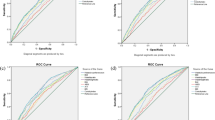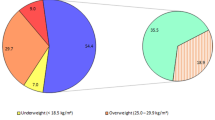Abstract
The purpose of this study was to examine the relationships between overall and central adiposity, a family history of coronary heart disease (FHCHD), and blood pressure (BP) in young children. We were specifically interested in determining whether the relationship between adiposity and BP was modified by a FHCHD. Subjects were 130 (68 males, 62 females) young children (mean age 6.0 years). Indicators of adiposity included the body mass index, waist circumference, skinfold thickness, and body composition determined by dual energy X-ray absorbtiometry (DXA). BP was measured by standard procedures. FHCHD was reported by the parent on a questionnaire. Approximately 19% of the total sample was classified as overweight and almost 50% were classified as prehypertensive (22.4%) or hypertensive (24.8%). In the total sample, 21 of 27 correlations were significant and ranged from 0.03 to 0.52. Correlations for systolic blood pressure appeared to be stronger in female subjects. Most of the correlations for diastolic blood pressure and mean arterial pressure were significant in both sexes and, in general, ranged between 0.30 and 0.50. Overweight status was significantly associated with high BP (crude odds ratio=3.65, 95% confidence intervals 1.40–9.49). There were no significant associations between a positive FHCHD and BP, and the correlations between BMI, WC, and BP were similar in magnitude in subjects with and without a FHCHD. In conclusion, both overall and central adiposity are important determinants of resting BP in young children. A FHCHD was not associated with BP and nor were the associations between adiposity and BP modified by a FHCHD.
This is a preview of subscription content, access via your institution
Access options
Subscribe to this journal
Receive 12 digital issues and online access to articles
$119.00 per year
only $9.92 per issue
Buy this article
- Purchase on Springer Link
- Instant access to full article PDF
Prices may be subject to local taxes which are calculated during checkout
Similar content being viewed by others
References
Guo S et al. Cardiovascular disease risk factors and body composition: a review. Nutr Rev 1994; 14: 1721–1777.
Berenson GS et al. Association between multiple cardiovascular risk factors and atherosclerosis in children and young adults. N Engl J Med 1998; 338: 1650–1656.
Berenson GS et al. Cardiovascular disease risk factor variables at the preschool age: The Bogolusa Heart Study. Circulation 1978; 57: 603–612.
Rolland-Cachera M-F et al. Adiposity rebound in children: a simple indicator for predicting obesity. Am J Clin Nutr 1984; 39: 129–135.
Cole TJ . Children grow and horses race: is the adiposity rebound a critical period for later obesity? BMC Pediatr 2004; 4: 6.
Prokopec M, Bellisle F . Adiposity in Czech children followed from 1 month of age to adulthood: analysis of individual BMI patterns. Ann Hum Biol 1993; 20: 517–525.
Freedman DS et al. BMI rebound, childhood height and obesity among adults: the Bogalusa Heart Study. Int J Obes Relat Metab Disord 2001; 25: 543–549.
Eriksson J et al. Early adiposity rebound in childhood and risk of Type 2 diabetes in adult life. Diabetologia 2003; 46: 190–194.
Kannel WB et al. The relation of adiposity to blood pressure and development of hypertension. The Framingham study. Ann Intern Med 1967; 67: 48–59.
Manson JE et al. A prospective study of obesity and risk of coronary heart disease in women. N Engl J Med 1990; 322: 882–889.
Hubert HB et al. Obesity as an independent risk factor for cardiovascular disease: a 26-year follow-up of participants in the Framingham Heart Study. Circulation 1983; 67: 968–977.
Williams RR et al. Are there interactions and relations between genetic and environmental factors predisposing to high blood pressure? Hypertension 1991; 18 (3 Suppl): I29–I37.
Bouchard C, Malina RM, Perusse L . Genetics of Fitness and Physical Performance. Human Kinetics: Champaign, IL, 1997.
Rice T et al. Genome-wide linkage analysis of systolic and diastolic blood pressure: the Quebec Family Study. Circulation 2000; 102: 1956–1963.
Allison DB, Heshka S, Heymsfield SB . Evidence of a major gene with pleitropic acion for a cardiovascular disease risk syndrome in children younger than 14 years. Am J Dis Child 1993; 147: 1298–1302.
Cui J, Hopper JL, Harrap SB . Genes and family environment explain correlations between blood pressure and body mass index. Hypertension 2002; 40: 7–12.
Pereira AC et al. Beta 2 adrenoreceptor functional gene variants, obesity, and blood pressure level interactions in the general population. Hypertension 2003; 42: 685–692.
Tiago AD et al. Angiotensinogen gene promoter region variant modifies body size-ambulatory blood pressure relations in hypertension. Circulation 2002; 106: 1483–1487.
Turner ST, Boerwinkle E, Sing CF . Context-dependent associations of the ACE I/D polymorphism with blood pressure. Hypertension 1999; 34: 773–778.
Malina RM . Anthropometry. In: Maud PJ, Foster C (eds). Physiological Assessment of Human Fitness. Human Kinetics: Champaign, IL, 1995; pp 205–219.
Cole TJ et al. Establishing a standard definition for child overweight and obesity worldwide: international survey. BMJ 2000; 320: 1240–1243.
Goran MI . Prediction of intra-abdominal and subcutaneous abdominal tissue in healthy prepubertal children. Int J Obes 1998; 22: 549–558.
Pinatauro S et al. Cross-calibration of fat and lean measurements by dual energy X-ray absorbtiometry to pig carcass analysis in the pediatric body weight range. Am J Clin Nutr 1996; 63: 293–299.
National High Blood Pressure Education Program Working Group on Hypertension Control in Children and Adolescents. The fourth report on the diagnosis, evaluation, and treatment of high blood pressure in children and adolescents. Pediatrics 2004; 114: 555–576.
Bensen JT et al. Accuracy of proband reported family history: the NHLBI Family Heart Study. Genet Epidemiol 1999; 17: 141–150.
Forde OH, Thelle DS . The Tromso Heart Study: risk factors for coronary heart disease related to the occurence of myocardial infarction in first degree relatives. Am J Epidemiol 1977; 105: 192–199.
Gerber LM, Stern PM . Relationship of body size and body mass to blood pressure: sex-specific and development influences. Hum Biol 1999; 71: 505–528.
Gutin B et al. Blood pressure, fitness, and fatness in 5- and 6-year-old children. JAMA 1990; 264: 1123–1127.
He Q et al. Blood pressure is associated with body mass index in both normal and obese children. Hypertension 2000; 36: 165–170.
He Q et al. Trunk fat and blood pressure in children through puberty. Circulation 2002; 105: 1093–1098.
Maffeis C et al. Waist circumference and cardiovascular risk factors in prepubescent children. Obes Res 2001; 9: 179–187.
Shear CL et al. Body fat patterning and blood pressure in children and young adults. The Bogalusa Heart Study. Hypertension 1987; 9: 236–244.
Geiss HC, Parhofer KG, Schwandt P . Parameters of childhood obesity and their relationship to cardiovascular risk factors in healthy prepubescent children. Int J Obes Relat Metab Disord 2001; 25: 830–837.
Eisenmann JC, Heelan K, Welk GJ . Assessing body composition among 3- to 8-year-old children: anthropometry, BIA, and DXA. Obes Res 2004; 12: 1633–1640.
Eisenmann JC et al. Stability of variables associated with the metabolic syndrome from adolescence into adulthood: the Aerobics Center Longitudinal Study. Am J Hum Biol 2004; 16: 690–696.
Forsen T et al. Growth in childhood and blood pressure in Finnish children. J Hum Hypertens 1998; 12: 397–402.
Garcia K, Eisenmann JC, Bartee RT . Does a family history of CVD modify the relationship between physical activity and blood pressure in young adults? Eur J Cardiovasc Prevention Rehab 2004; 11: 201–206.
van Dam RM et al. Parental history of diabetes modifies the association between abdominal adiposity and hyperglycemia. Diabetes Care 2001; 24: 1454–1459.
Sellers TA et al. Interaction of waist/hip ratio and family history on the risk of hormone receptor-defined breast cancer in a prospective cohort study of postmenopausal women. Am J Epidemiol 2002; 155: 225–233.
Khaw KT, Barrett-Connor E . Family history of heart attack: a modifiable risk factor? Circulation 1986; 74: 239–244.
Lever AF, Harrap SB . Essential hypertension: a disorder of growth with origins in childhood? J Hypertens 1992; 10: 101–120.
Higgins M . Epidemiology and prevention of coronary heart disease in families. Am J Med 2000; 108: 387–395.
Margaglione M et al. Genetic polymorphism of 5,10-MTHFR reductase gene in ofspring of patients with myocardial infarction. Thromb Haemost 1999; 82: 19–23.
Boer JM et al. Parental history of myocardial infarction: lipid traits, gene polymorphisms and lifestyle. Atherosclerosis 2001; 155: 149–156.
Tiret L et al. Gene polymorphisms of the renin–angiotensin system in relation to hypertension and parental history of myocardial infarction and stroke: the PEGASE study. Projet d'Etude des Genes de l'Hypertension Arterielle Severe a moderee Essentielle. J Hypertens 1998; 16: 37–44.
Maeda Y et al. Angiotensin-converting enzyme gene polymorphism in hypertensive individuals with parental history of stroke. Stroke 1996; 27: 1521–1523.
Malina RM . A multidisciplinary, biocultural approach to physical performance. In: Ostyn M, Beunen GP, Simons J (eds) Kinanthropometry II, vol 9. Univerity Park Press: Baltimore, 1980, pp 33–68.
Hawe E et al. Family history is a coronary heart disease risk factor in the Second Northwick Park Heart Study. Ann Hum Genetics 2003; 67: 97–106.
Acknowledgements
The data were collected when JCE was at York University, Toronto, Ontario, Canada. This work was supported in part by a York University Faculty of Arts Research Grant awarded to JCE and a University of Nebraska at Kearney Grant awarded to KAH. We acknowledge Heather McArel, Chad Cook, and Ryan D Krueger for their assistance in data collection.
Author information
Authors and Affiliations
Corresponding author
Rights and permissions
About this article
Cite this article
Eisenmann, J., Wrede, J. & Heelan, K. Associations between adiposity, family history of CHD and blood pressure in 3–8 year-old children. J Hum Hypertens 19, 675–681 (2005). https://doi.org/10.1038/sj.jhh.1001882
Received:
Revised:
Accepted:
Published:
Issue Date:
DOI: https://doi.org/10.1038/sj.jhh.1001882
Keywords
This article is cited by
-
Waist-to-height ratio and skipping breakfast are predictive factors for high blood pressure in adolescents
Scientific Reports (2020)
-
Human cytomegalovirus infection and coronary heart disease: a systematic review
Virology Journal (2018)
-
Blood pressure and associated factors in a North African adolescent population. a national cross-sectional study in Tunisia
BMC Public Health (2012)
-
Validity of body mass index and waist circumference to detect excess fat mass in children aged 7–14 years
European Journal of Clinical Nutrition (2011)
-
Assessing secular trends in blood pressure in children and adolescents
Journal of Human Hypertension (2009)



